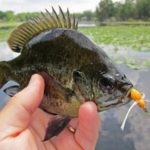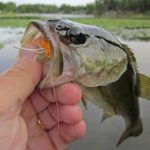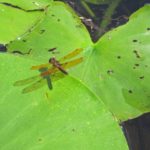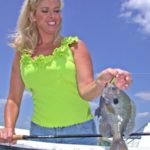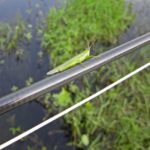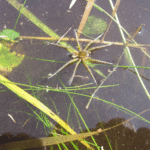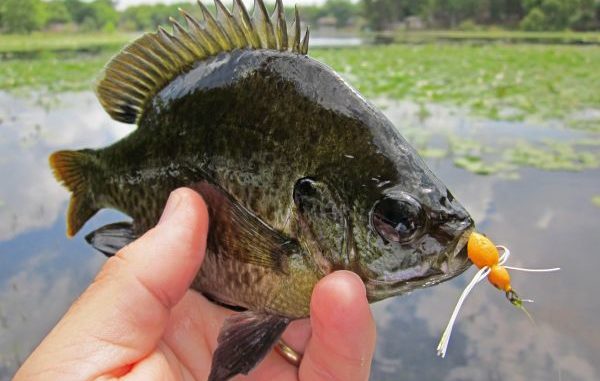
Louisiana Sportsman columnist shares best fly-fishing tactics for frenzied panfish trips.
The sounds are unmistakable. SSSLURP! POP! SMACK!
When bluegill rise to grab surface meals, they know they’re vulnerable to bass, ospreys, herons and other predators. Therefore, they have to be sure of a worthwhile payoff, and nature provides plenty in the way of aquatic insects and other bugs that fall to the water’s surface.
Even those meals perched on lily pads or hovering too close to the strike zone are subject to attack from these feisty panfish.
Savvy anglers can take advantage of this aggressive feeding by presenting small flies that mimic water bugs and ill-fated flying insects.
A great pastime for kids and beginning fly fishermen alike, the pursuit of bluegill also entertains even the most experienced anglers by blending a high level of sport with a comfortably casual vibe that reminds us all of our angling roots. To help detail this simple yet instantly addictive activity, we sought the sage advice of Louisiana Sportsman’s fly fishing columnist Glen “Catch” Cormier.
Notwithstanding his prowess with many of the state’s larger and more glamorous fish, Catch holds the bream in high regard.
“Pound for pound, I think bluegill are the strongest fish in freshwater,” Cormier said. “Also, because they’re omnivores, they’ll eat just about anything.
“So there’s a variety of flies you can throw — popping bugs, submergents. You don’t have to be really particular as long as it looks like something small that they can eat.”
Moreover, bluegill have long enjoyed an honored station in the annals of Bayou State freshwater fishing. An abundant food source, this feisty panfish has made a lasting mark on the collective angling consciousness.
“If you look back at the history of fly fishing in Louisiana, almost all of it was bass and bluegill,” Cormier said. “You can go into some of the old bait shops in North Louisiana and Central Louisiana and find fly rods from 30 to 40 years ago hanging on the walls, and they have a popping bug on them.”
Tackle up
When it comes to arming yourself for panfish pursuits, a 7-foot, 3-weight outfit will certainly handle the duty while offering a sporty tussle.
However, because bluegill often share the same habitat with largemouth bass, you might consider upsizing your gear just enough to handle the bigger and more powerful predators that smack diminutive bream flies with surprising regularity.
Cormier suggests an 8- to 8 ½-foot, 5-weight outfit, with a preference on the shorter version: Given the abundance of vegetation lining much of Louisiana’s shorelines, rods of lesser length prove particularly beneficial to bank fishermen often dealing with limited casting areas.
Whatever length you go with, modern tackle selection offers anglers much more bang for their buck, so even a beginner’s budget can accommodate a solid fly-fishing outfit well capable of handling bluegill.
“When I was young, we had fiberglass rods that were heavy, and they had a lot of swing when you threw them,” Cormier said. “Now, you can go to Cabela’s or Bass Pro Shops or any of the sporting goods stores and get a graphite rod for about the same amount of money.
“Today’s equipment is so much better.”
Fly fishing purists enjoy building their own leaders with just the right knots and tippet, but the one-piece tapered leaders sold at fly-fishing retailers offer fine options for the casual bluegill angler.
As for line, just keep it simple — floating line for poppers and other surface flies, and sink-tip line for submergents.
Often, some of your best bluegill action can occur in the most unlikely of spots. Retention ponds, roadside canals and golf course water hazards (when access is allowed) often produce great action with fish that rarely see a hook.
To make sure you don’t miss any such opportunities, keep a multi-piece outfit in your vehicle or luggage. Cabela’s, for example, offers a handy travel kit with room for a four-piece rod, reel and spare line and leaders.
Local cuisine
The timeless “match-the-hatch” mantra driving the intricate decision-making process of trout stream perfectionists is far less stringent for bluegill pursuits. The fact is that these gluttons just aren’t terribly picky.
Nevertheless, despite their aggressive nature and diverse tastes, bluegill certainly respond best to flies that resemble the natural forage common to their habitat. In most cases, that means a mix of insects that live in the water (i.e. beetles), those that inhabit aquatic vegetation (water spiders), and those that buzz near and often fall into the water (bees, dragonflies, moths, horseflies, etc.).
Look at the kind of insects; note not only their species and coloration, but is there a lot of flying insects falling to the surface, or is it more aquatic insects like water beetles or spiders. Whatever the common food source, you can usually make a close enough resemblance with common bluegill flies to convince the fish.
Cormier said a basic bluegill fly box should include popping bugs of various sizes and color, several foam spiders and a selection of bead-head flies like Wooly Boogers or Jitterbees, which reach below the surface.
If your budget allows multiple rods, rig one with a popper or foam-bodied fly and another with a beaded fly. This way you can continuously test each spot to see where the fish prefer to eat.
Generally, temperature extremes of summer and winter keep the fish lower in the water column, but a warm winter’s day or the cooler hours of a summer day can find the fish popping bugs off the surface.
If you want to get fancy, rig a popper with a subsurface fly about a foot behind and note which one the fish eat. Often the popper will get the fish’s attention, while the sinking fly gets the bite.
“Sometimes, when you find bluegill on the beds, they won’t eat anything that you have to move fast on the surface,” Cormier said. “But if you throw a wet fly in there and just let it sink slowly, they’ll nail it.”
Where to cast
Practically any lily pad stand, laydown, or weed mat perimeter holds bluegill potential. Cormier notes that grass lines are particularly important to bluegill, so pay close attention to fields of this cover.
“Lakes like Cataouatche, D’Arbonne and Chicot have a lot of grass, and bluegill love that kind of habitat,” he said. “It contains a lot of the insects, bugs, grass shrimp and organisms that bluegill feed on. It gives them cover, there’s a lot of food availability and they can sit there in the shade during the heat of the day.
“It’s also attractive (spawning habitat) as well.”
Generally speaking, you’ll want an unobstructed course through which to strip your fly, so look for notches, channels and lanes within the overall habitat and target accordingly.
Of course, if you’re confident with your casting and, more importantly, your ability to pick up line, any gaps or “windows” in a weed mat or lily pad stand can be gold mines of bluegill opportunity.
When fishing around heavy vegetation, check your flies often, especially if their action or the way they sit in/on the water suddenly changes. Likely problems include debris, algae strands or plant pieces on the fly. If you snag a pad, for example, always check to make sure a dime-sized piece did not get impaled on the hook when you pulled it free.
Drain pipes, spillways and feeder creeks are always a good bet, especially after heavy rains. Rushing water creates current and that’s a natural fish magnet, as it stirs up the bottom and shakes out lots of tasty morsels for panfish, bass and others. Also, these run-outs deliver lots of insects and panfish are quick to access the bounty.
Similarly, a good rain will wash loads of fresh forage into the water, so grab that fly rod as soon as the weather clears.
Prudent presentation
During the temperature extremes of summer and winter, expect the fish to be holding deeper, usually in some type of vegetation that holds heat.
During these times, the fish are unlikely to venture topside, except for summer’s cooler morning and evening hours or a nice warm spell during winter. Aside from these moderate periods, you’ll do best with sinking or sink-tip line and weighted flies like a bead-head Wooly Bugger.
During mayfly hatches, willows and other waterside vegetation will often hold hundreds of newly emerged flies. Reach in and shake the branches to shake a bunch of the insects to the water. Bluegill don’t miss many meal opportunities, so the ensuing action will offer plenty of opportunities for sneaking a fly into the feeding frenzy.
Often, when one bluegill strikes at a surface target and doesn’t get a solid grip on the bug, another fish will take advantage of the easy meal by grabbing it while it drifts helplessly below the surface. You can jump right to this scenario with a simple field adjustment: Just wrap a small amount of lead wire around your floating fly’s hook, thereby making it a slow-sinking or suspending fly.
“The biggest mistake I see people make is too much casting,” Cormier said. “You’re not fishing for birds; you’re fishing for fish. It only takes one cast.
“And be patient — that’s the biggest part of bluegill fishing. Slow — you just throw it out there and let it sit. You move it an inch or a couple of inches, and then you let it sit. They like to nibble a lot, but the payoff can be really good.”
